Based on the Master Thesis by Sarah Dobjani / Frankfurt University of Applied Sciences in cooperation with the TUMI E-Bus Mission. For the full publication version of the thesis, click here.
The global shift towards electrifying public transport as a response to climate change and air pollution introduces challenges for the workforce, particularly in developing countries where precarious working conditions are prevalent. Focusing on the transition from diesel to e-buses in Mexico City’s BRT – Metrobús Line 3, the aim is to understand its impact on the public transport sector workforce. Surveys, expert interviews and secondary research unveil positive and negative aspects of bus fleet electrification, highlighting the transition as an opportunity to comprehensively address workforce issues, rather than solely a technological change. A proposed three-level categorization of measures emphasizes the need for coordination to achieve a Just Transition, potentially benefiting the entire public transport workforce in Mexico, not only Metrobús Line 3.
The transport sector in Mexico, a crucial driver of economic growth, contributes to environmental and health risks through air pollution. Despite legislative commitments and support for electrification, challenges persist, including resistance from private operators, aging bus fleets and workforce issues. The lack of a comprehensive plan for achieving electrification targets in Mexico City highlights the need for inclusive strategies addressing regulatory gaps, professionalization, gender imbalances and the rapid integration of new technologies.
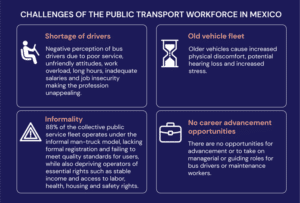
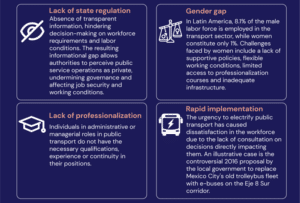
Metrobús, established in 2004 to optimize demand coverage in Mexico City, transitioned Line 3 from diesel to electric buses, operating 60 e-buses by March 2023. This transition, strategically selected for operational efficiency, passenger load and fleet age, is expected to yield substantial benefits, including an 80% reduction in energy costs, prevention of 300,000 tons of CO2 emissions over a decade and operational advantages, despite initial challenges and upfront costs.

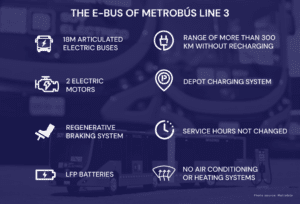
The Metrobús’ Line 3 public transport workforce’s perspectives on the transition, as gathered from the surveys, provide insights into their experiences, challenges and suggestions for improvement. The findings highlight overall satisfaction among e-bus drivers and maintenance staff, with positive aspects such as an improved work environment. However, challenges arising from innovative electric technology, the newness of buses and broader challenges affecting the workforce are identified.


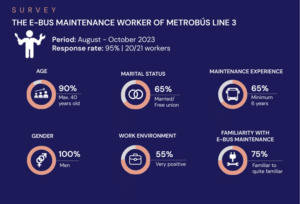

Positive effects of e-bus technology
Improved work environment through comfort and safety
- Healthier work environment due to the electric engine’s emission-free operation, reducing pollution.
- Lower heat emission compared to ICE buses, ensuring a fresher environment for the drivers.
- Reduced engine noise promotes attentiveness, lowering the risk of accidents and enhancing safety.
- Automatic gears improve physical comfort by decreasing pressure on body muscles while in use.
- Elimination of lubricants for maintenance staff contributes to a healthier work environment.
Increased satisfaction and motivation
- Decreased workload for maintenance staff, optimizing operational processes.
- Pride and excitement among the workforce for operating and maintaining state-of-the-art buses.
- Improved public image of public transport positively influences the perception of drivers.
- Workforce motivation for environmental responsibility, contributing to a healthier public space.
- Continuous learning about new technology promotes a motivated and skilled workforce.
Challenges related to the electrification of the Metrobús Line 3 bus fleet
Since e-bus technology aims to tackle pollution and climate change, a comprehensive understanding of workforce issues is critical in order to effectively provide recommendations for change.
Challenges directly linked to the electrification
- Adjustment issues to the new driving method
- Lack of safety equipment, such as antistatic uniforms and insulated tools
- Lack of ongoing training for both e-bus drivers and maintenance staff
- Potential job displacement and loss affecting older workers
Challenges associated with the newness of e-buses
- Addition of door sensors causing drivers stress and sever delays
- Uncomfortable driver’s seats due to insufficient padding
- Lack of air conditioning and ventilation
- Invasion of privacy due to surveillance cameras inside the buses
Broader challenges
Institutional challenges
- The prioritization of private motor vehicle infrastructure, due to Mexico’s major automobile manufacturing sector
- Lack of professionalization in administrative or management positions
- Absence of Just Transition clauses in official policies concerning transport
- Metrobús’ limited role in decisions concerning employee working conditions
Driver shortage and gender imbalance
Due to poor job conditions, limited career prospects and a negative professional image, exacerbated by low female representation, driver shortage is a major issue in the whole Latin American region, including Mexico.
The technology itself has a predominantly positive impact on the workforce since the workforce generally embraces the technology but expresses concerns about its implications. While delving into the specific challenges posed by the technology, it is imperative to step back and consider the broader issues confronting the public transport workforce in Mexico. Addressing these overarching challenges is crucial, as the rapid implementation of the technology in response to climate change and pollution urgency risks legitimizing the persisting job precariousness in this profession. The transition to electrification should be viewed not merely as a technological response but as a window of opportunity to fully analyze and address all factors influencing the public transport workforce, ensuring a comprehensive resolution of their issues rather than using the transition as a veil for underlying problems.
Drawing insights from literature review, surveys and interviews, recommendations for implementing measures aimed at achieving a Just Transition for the workforce of Metrobús Line 3 are provided. These proposed measures aim not only to alleviate the challenges faced by this specific workforce but also provide larger benefits for the public transport workforce in Mexico as a whole. The recommended measures are categorized into three levels, based on the primary actor responsible for their implementation. It is critical to emphasize that effective implementation of these measures requires coordination and cooperation of all three levels.
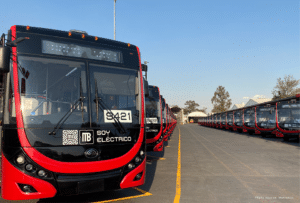
Operator-level recommendations
- Ongoing training: Continuous training beyond one month is recommended for enhancing the competency of e-bus drivers and maintenance staff, as indicated by surveys reflecting their mutual desire for ongoing skill development in adapting to new driving methods and high-voltage systems.
- Ensuring workplace safety: Providing PPE (personal protection equipment) for maintenance workers and shelters for drivers in cases of extreme weather events is crucial for ensuring safety.
- Enhancing gender inclusivity in driving & maintenance roles: Proactively foster gender diversity by implementing targeted actions to increase women’s representation in traditionally male-dominated roles, leveraging benefits of electrification to improve work conditions and counter workplace discrimination.
Transport-authority-level recommendations
- Strengthening the authority of Metrobús: Enhance Metrobús’s authority to supervise companies’ compliance with Just Transition measures by providing additional government subsidies to companies electrifying their bus fleets through the Metrobús account, based on meeting workforce-related Just Transition conditions formulated with trade unions and stakeholders. This financing approach incentivizes Just Transition measures, while increasing Metrobús’s influence on workforce decisions.
- Collaborative efforts to address driver shortage & gender imbalance: Metrobús should collaborate with governmental bodies, private companies, trade unions and stakeholders to implement initiatives such as providing specialized training exclusively for women, overcoming licensing barriers, partnering with public technical education institutions and employing innovative financial mechanisms.
- Establishing a Just Transition Committee: Establish a Just Transition Committee for workers to discuss concerns and propose ideas to improve work conditions and quality of life.
Policy-maker-level recommendations
- Increasing subsidies for the electrification of bus fleets: Increasing subsidies for concessioned companies implementing electric mobility through the Metrobús financing scheme is one measure to address insufficient federal funding for public transport.
- Tackling the gender imbalance in the sector: It is imperative to adopt a gender-sensitive approach in policy development. This involves incorporating gender equity clauses into institutional frameworks and funding agreements.
- Incorporating Just Transition clauses into official strategic documents: Official documents related to public transport electrification should integrate Just Transition clauses such as social dialogue and collective bargaining.
- Establishing an independent body for public transport oversight: An independent body comprising local stakeholders and engaged organizations can ensure unbiased decision-making, unaffected from political factors such as elections.
Conclusion
The research not only offers insights for Metrobús and policymakers to assess employee satisfaction and formulate strategies but also empowers workers to voice their needs, influencing future procurement decisions. By incorporating social dialogue and collective bargaining, policymakers can ensure a Just Transition for the entire public transport workforce, beyond just Metrobús Line 3. With the transition still in its early stages, ongoing surveys and consultations are vital to address emerging challenges effectively. Moreover, the survey methodology can be adapted for use in other cities worldwide, providing valuable insights into the complexities of transitioning to e-buses while considering contextual differences.
References
Asia-Pacific Economic Cooperation (APEC) Energy Working Group (2022). Planning a Transition to Electrification of Public Transit Systems: Learnings from the Bus Rapid Transit System of Metrobus in Mexico City. [online] Available at: https://www.apec.org/docs/default-source/publications/2022/10/planning-a-transition-to-electrificatio n-of-public-transit-systems-learnings-from-the-bus-rapid-transit-system-of-metrobus-in-mexico-city/2 22_ewg_planning-a-transition-to-electrification-of-public-transit-systems.pdf?sfvrsn=587548d3_2 [Accessed Jul. 2023].
De La Torre Ríos, G. and Delgado Miranda, J. (2023). Female labor inclusion in public transportation. Case study: The Mujeres Conductoras Program in Jalisco, Mexico. [online] Transformative Urban Mobility Initiative (TUMI). Available at: https://transformative-mobility.org/multimedia/inclusion-laboral-femenina-en-el-transporte-publico-est udio-de-caso-del-programa-mujeres-conductoras-en-jalisco-mexico/ [Accessed Jul. 2023].
Delgado Miranda, J. (2023). Benefits of electric buses on the quality of life of public transport drivers. [online] Available at: https://transformative-mobility.org/multimedia/beneficios-de-los-autobuses-electricos-en-la-calidad-d e-vida-de-los-conductores-de-transporte-publico/ [Accessed Jul. 2023].